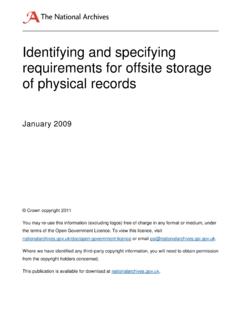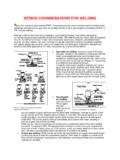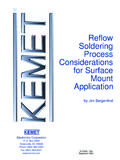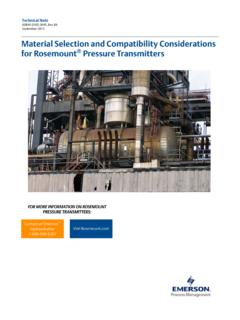Transcription of Selection, Design Considerations and Details - rlcraigco.com
1 Craig Company, Inc. 502-244-1600 Serving the HVAC Industry Since 1955 Louvers Selection, Design Considerations and Details Written by Matt Trentham, Craig Company, Inc. Louvers are a basic and simple part of many HVAC systems and buildings, but they are often overlooked or not given the proper amount of Design time and consideration. The purpose of this paper is to describe the proper way to select louvers, as well as point out application issues and common louver features and accessories. It is written for the beginner to the advanced reader in mind.
2 To prevent the paper from being too long, some topics are only briefly mentioned. Additional conversations, Details and supporting documents may be necessary to address specific applications. Basic Selection 1. Determine the air flow, direction of air flow and maximum air pressure drop. 2. On the Airflow Resistance chart, start at the selected static pressure and draw a horizontal line across, until it intersects either the intake line or the exhaust line. At the intersection point, draw a line straight down to the free area velocity line. 3. Check the Water Penetration Chart to make sure the recently determined free area velocity is less than the beginning point of water penetration velocity.
3 4. Calculate the free area required on the louver by taking the air flow amount and divide it by the recently determined free area velocity. 5. Go to the Free Area Chart and select a louver that has a free area equal to or greater than the value found in item # 4. 6. As a minimum, your louver schedule should include: manufacturer s name, louver model number, width, height, depth, free area, air flow amount, direction of air flow, static pressure drop and free area velocity. R. L. Craig Company, Inc LOUVERS SELECTION, Design & Details 2 | Page Craig Company, Inc.
4 502-244-1600 Serving the HVAC Industry Since 1955 R. L. Craig Company, Inc LOUVERS SELECTION, Design & Details 3 | Page Craig Company, Inc. 502-244-1600 Serving the HVAC Industry Since 1955 More Advanced Selection Concerns 1. The data calculated and reported in the Airflow Resistance Chart is based on a louver without a bird or insect screen. Most bird screens have a nominal pressure drop, but there are circumstances when their effects should not be overlooked. Insect screens have very high pressure drops, clog with dirt quickly and are rarely cleaned.
5 We recommend insect screens only be used when required by the FDA or for other special applications. 2. The data calculated and reported in the Free Area chart is based on a 48 x 48 louver. As the louver height decreases, the percentage of free area to total outside dimension area decreases. That is because the shorter the overall louver, the more the louver blades get in the way. 3. For louvers greater than 48 high, performance data in the columns can be taken as linear in between the reported points. Therefore, using interpolation is an accurate way to obtain a free area for a louver height other than one listed.
6 For louvers between 24 and 48 high, the data is somewhat linear in between the reported data points. For louvers less than 24 high, the data is not linear in between the reported data points because of blade spacing issues. Interpolation is not accurate for small sizes. We strongly recommend either using the lower published data point shown in the chart or contact us for the exact free area. Interpolation is accurate for all louver width data points. 4. The data shown in the Water Penetration table is based on an AMCA test standard. The standard requires a 48 x 48 louver and a certain amount of simulated rain drops which fall straight down.
7 Several real world factors are not included in this laboratory test. They are: wind driven rain, the effects of a louver installed low on a high wall, wind pressure against a large wall and rates of rain greater than the AMCA dripping test. The AMCA test is similar to a nice and gentle springtime rain that lulls a person to sleep. Unfortunately, many rainstorms are more aggressive than the conditions found in the test laboratory. For example, an average beginning point of water penetration for an average louver might be 1,000 fpm.
8 Although 1,000 seems like a big number, when converted to the more recognizable measurement of mph, it becomes plausible that rain will enter the louver even though it was selected properly. 5. Rain and snow will pass through most, if not all, standard louvers. We recommend some means of trapping, holding, containing or draining the water be incorporated into the Design of every louver installation. Depending on the application, it can be as simple as sloping the duct back to the louver, sealing joints water tight, including weep holes in the louver frames, etc.
9 Larger installations may require drain pans or mist eliminators. 6. For critical water penetration applications, we recommend using louvers which are AMCA Certified for Wind Driven rains. These louvers are tested at 29 mph - 3 /hr rain fall rate and 50 mph - 8 /hr rain fall rate. They are usually 99 to 100% effective. Their drawback is because they have a lower free area percentage, a larger louver is required to prevent excessive intake velocity and pressure drop. R. L. Craig Company, Inc LOUVERS SELECTION, Design & Details 4 | Page Craig Company, Inc.
10 502-244-1600 Serving the HVAC Industry Since 1955 7. For critical structural integrity and water penetration applications, we recommend using louvers which are Miami-Dade Enhanced Hurricane Qualified. With the amount of high winds, tornados and heavy rains we experience in Kentucky and Southern Indiana, this type of louver has become a valuable problem solving option. 8. When adding a motorized damper or gravity damper to the back side of the louver, take the extra time to specify the damper by model number and detail it accurately. This will prevent guessing and field problems later.







